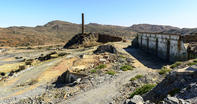Mine at Spektakel
The copper mine at Spektakel, owned by Phillips and King, was in a precarious position. The lease was granted in 1853 and pits were sunk. By 1856, only one pit had proved worthy of exploitation, but it was really rich.

In 1861, it produced more ore than the mighty Okiep mine and, by 1863, Spektakel had grown into the largest village in Namaqualand. A school was established a few years later, but the mine was already petering out. Workers were transferred to other mines and the school closed down less than a year after it opened. In 1867, production slowed to a meagre 49 tons of ore.
The following year, production resumed but on a small scale, and smelting works were constructed to reduce the ore to more profitable grades (known as regulus). Things seemed to be looking up. In 1869 a mission school was established and, in 1871, the grandly-named Spektakel Examiner and Times and Namaqualand Advertiser began its circulation to a reported 600 inhabitants.
Two topics that were regularly discussed in the hand-written circular were the lack of a law officer and the ongoing problem with stray dogs. Then, in 1872, the mine failed again, but work continued sporadically. The town dwindled, only to recover a few years later when the mine improved.
A Bad Year For Mines

1886 was a bad year for the mines, with a slump in the price of copper causing many mines to close down. Prices rebounded two years later, thanks to the efforts of a London-based syndicate funded by the copper companies, and Spektakel was opened yet again. But, by 1890, there were reports that the people at the nearby village of Kommagas were suffering because work had been suspended at Spektakel once more.
The mine was now valued at £100 pounds (£2000 if you included the value of buildings and equipment). Nevertheless, the mine stumbled on until 1901 when it was finally put to rest as a result of the Anglo-Boer war. The last entry in the mine manager’s journal reads "Mine abandoned due to marauding Boers". Today, Spektakel is a small village and a popular site on the spring flower route.
Second Biggest Mine
Nababeep was a more substantial proposition as a copper mine. It began as a farm, Lelykepad (bad road) which was granted to Pieter van Zyl in 1850. In 1852 it was purchased by Phillips and King for £1000. For the next few decades it was considered to be a very promising trial mine, slowly growing into a complex with several shafts, a smelting works, winding engines, stone breakers etc.
By 1902, it was the second most important producing copper mine in the group. By 1908, it had a population of more than 2000 people. Nababeep closed during the copper slump of 1919, but reopened in 1937 and continued to operate, albeit under constant threat of closure, until the early 1980s.
Today, there is a sleepy village at Nababeep and an interesting mining museum. Amazingly, a private consortium is currently trying to re-start the mine after all these years.
By David Fleminger